Derek Cohen (Perth Oz)
Established Member
The Orange Block Plane – a review
After paring chisels and spokeshaves, my favourite tool is a block plane. These tools all have in common “feel”, a more direct involvement with the wood.
My block plane collection of regular users centres on four planes, Stanleys #18 Knuckle joint (62 degree cutting angle) and #65 Knuckle joint (37 degree cutting angle), and Lie Nielsens #60 ½ (37 degree cutting angle) and bronze #103 (45 degree cutting angle).
The #18 is used as a small smoother for difficult face grain. The #65 (with a Hock blade) is probably the best performer of the lot. However, it is quite a large block plane and the LN #60 ½ is more comfortable in the hand. The little #103 is the one I grab first when I work away from the bench. Its small size disguises a plane with the heft of something significantly larger. It does lack the ultimate performance of its bigger sibling owing to having a larger mouth.
I was asked to review The Orange Block Plane by my son, Jamie, who has owned it since it was discovered in the bargain bin of Bunnings (the local borg) several years ago. At the time I felt that the $5 asking price was daylight robbery. Still, it does have some novel features, and I shall come to these in due course.
I had not used this plane in some years. It had originally been purchased for Jamie (then 6 years old) to practice on in the workshop. He stored it amongst his treasures at the back of his wardrobe under a pile of old socks. He is now 13 years old and was recently re-introduced to woodworking at high school by Ms Robinson. He seems keen.
Who manufactures The Orange Block Plane? Who indeed? It has no markings at all. Perhaps, this is a deliberate ploy of Triton (who shares this colour scheme) to manipulate everyone into using their ‘tailed routers instead!
Here is the collection of block planes mentioned above. See if you can spot The Orange Block Plane.

And in case you had any difficulty, here is a close up:
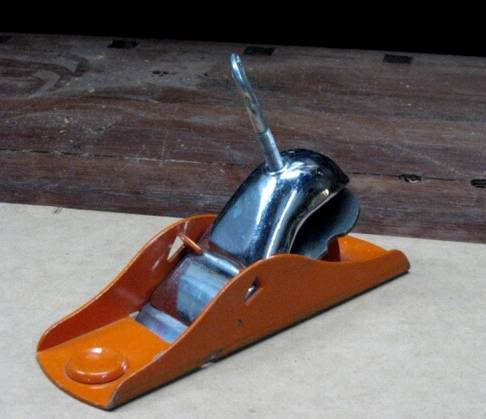
Important features of TOBP (The Orange Block Plane)
· Pressed steel construction that is even more durable than Ductile Iron.
· Bright orange colour will not get lost among the mess … uh work-in-progress of the average workbench. Here is a close up of the colour:
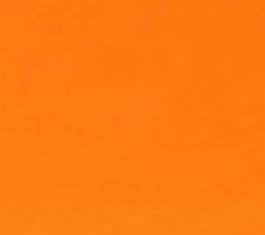
· No moving parts to wear out.
· Admittedly, a modification had to be made to the lever cap. The original black plastic knob broke after being subjected to a stress test (i.e. it was eaten by Rufus, the dog), and a steel bolt was used as a replacement. This has proved a very successful upgrade.
· The lever cap screw now doubles as a hang hole.
· Construction has been simplified so that it is possible to press all pieces out of the same piece of steel. Hopefully no one gets confused and sharpens up the wrong bit.
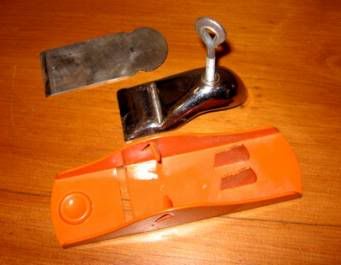
· The absence of a bed for the blade is a brave new design. The blade hangs in the air at 20°.
· There is a finger hole at the front for your finger. It is a single finger hole designed for a single finger.
· The sole has been lapped to .00000001mm deviation across its length of 6 3/8”.
· It has a blade. It is made out of steel. For the technical boffins amongst us, it is 1 5/8” wide and 5/64” (2mm) thick, or vice versa.
· It also has a mouth – somewhat reminiscent of the Grand Canyon:
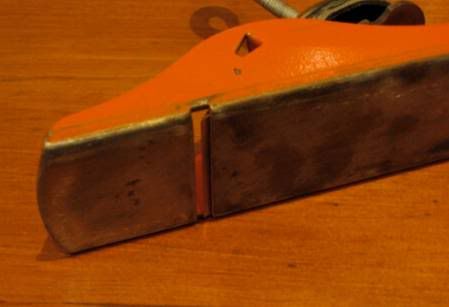
· The edges are rounded (so that you do not cut yourself?).
Tuning up The Orange Block Plane
Surprisingly, the plane was not ready to go out of the box. It required tuning. The original bevel appeared to be honed at 45°. This was re-ground to 25° and I freehand sharpened it to 8000 grit.
The back of the blade had a low area throughout its length and width, a lot like a Japanese blade. I’m sure it was on purpose. It was possible to flatten it at the important back edge of the bevel.
I assumed that I lapped the sole all those years ago as it was flat against a straight edge. I made no effort to flatten it this time around.
The blade was place on the rear of the mouth and the cap iron tightened down. Fine adjustment was made with a mallet. The large mouth was ignored and the blade projection was considered sufficient once fine shavings emerged.
Making Shavings
Planing of pine face grain was completed by Jamie. Here is his style:
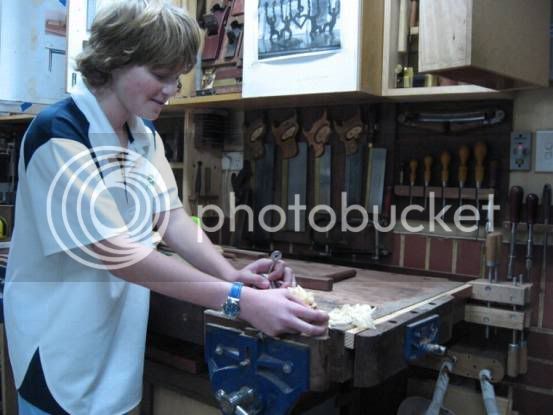
And here are the shavings he made:
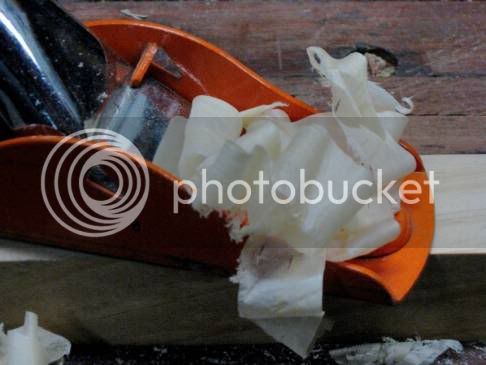
A little later I attempted to cut pine endgrain:
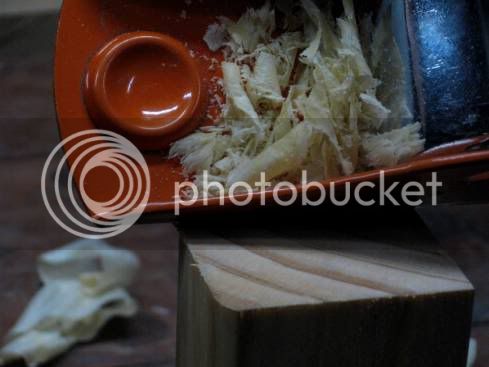
The resultant surface was actually pretty good. Pine end grain actually has a high rating on the difficulty scale. The soft wood fibres do not “stand up” to be cut, and a clean slice is a good measure of the blades ability to penetrate these fibres. What we would call “sharp” is really a combination of the smoothness and the angle of the bevel. A lower cutting angle and a smoother bevel equate to easier penetration.
Summing up
One might assume that my regular block planes are in no danger of being replaced by The Orange Block Plane, but this is not certain. The Orange Block Planet does give them a run for their money under these conditions (I did do some planing with the #65 and #60 ½, and they really did not produce any better results on this piece of pine).
The Orange Block Plane is really more than just a paperweight. It is probably one of the more “distinctive” planes I have used – indeed the colour causes me to be transfixed like a kangaroo in the headlights of my ute * on a dark night – I reckon that it would look pretty sharp in a belt holster made from a converted neoprene stubby holder **.
There is definitely something machismo about this plane. One could saunter into the pub, lean against the bar, and attract admiring glances as you casually toss it onto the counter. It says “I am not affected by fashion … (I am cheap).” And to the kids, “One day this could be yours if you are good … (because I am cheap)”.
Well that’s about it. You were expecting more? For $5? Yeah … right.
Derek Cohen
Perth, 2006
* Utility vehicle
** Beer holder
After paring chisels and spokeshaves, my favourite tool is a block plane. These tools all have in common “feel”, a more direct involvement with the wood.
My block plane collection of regular users centres on four planes, Stanleys #18 Knuckle joint (62 degree cutting angle) and #65 Knuckle joint (37 degree cutting angle), and Lie Nielsens #60 ½ (37 degree cutting angle) and bronze #103 (45 degree cutting angle).
The #18 is used as a small smoother for difficult face grain. The #65 (with a Hock blade) is probably the best performer of the lot. However, it is quite a large block plane and the LN #60 ½ is more comfortable in the hand. The little #103 is the one I grab first when I work away from the bench. Its small size disguises a plane with the heft of something significantly larger. It does lack the ultimate performance of its bigger sibling owing to having a larger mouth.
I was asked to review The Orange Block Plane by my son, Jamie, who has owned it since it was discovered in the bargain bin of Bunnings (the local borg) several years ago. At the time I felt that the $5 asking price was daylight robbery. Still, it does have some novel features, and I shall come to these in due course.
I had not used this plane in some years. It had originally been purchased for Jamie (then 6 years old) to practice on in the workshop. He stored it amongst his treasures at the back of his wardrobe under a pile of old socks. He is now 13 years old and was recently re-introduced to woodworking at high school by Ms Robinson. He seems keen.
Who manufactures The Orange Block Plane? Who indeed? It has no markings at all. Perhaps, this is a deliberate ploy of Triton (who shares this colour scheme) to manipulate everyone into using their ‘tailed routers instead!
Here is the collection of block planes mentioned above. See if you can spot The Orange Block Plane.

And in case you had any difficulty, here is a close up:

Important features of TOBP (The Orange Block Plane)
· Pressed steel construction that is even more durable than Ductile Iron.
· Bright orange colour will not get lost among the mess … uh work-in-progress of the average workbench. Here is a close up of the colour:

· No moving parts to wear out.
· Admittedly, a modification had to be made to the lever cap. The original black plastic knob broke after being subjected to a stress test (i.e. it was eaten by Rufus, the dog), and a steel bolt was used as a replacement. This has proved a very successful upgrade.
· The lever cap screw now doubles as a hang hole.
· Construction has been simplified so that it is possible to press all pieces out of the same piece of steel. Hopefully no one gets confused and sharpens up the wrong bit.

· The absence of a bed for the blade is a brave new design. The blade hangs in the air at 20°.
· There is a finger hole at the front for your finger. It is a single finger hole designed for a single finger.
· The sole has been lapped to .00000001mm deviation across its length of 6 3/8”.
· It has a blade. It is made out of steel. For the technical boffins amongst us, it is 1 5/8” wide and 5/64” (2mm) thick, or vice versa.
· It also has a mouth – somewhat reminiscent of the Grand Canyon:

· The edges are rounded (so that you do not cut yourself?).
Tuning up The Orange Block Plane
Surprisingly, the plane was not ready to go out of the box. It required tuning. The original bevel appeared to be honed at 45°. This was re-ground to 25° and I freehand sharpened it to 8000 grit.
The back of the blade had a low area throughout its length and width, a lot like a Japanese blade. I’m sure it was on purpose. It was possible to flatten it at the important back edge of the bevel.
I assumed that I lapped the sole all those years ago as it was flat against a straight edge. I made no effort to flatten it this time around.
The blade was place on the rear of the mouth and the cap iron tightened down. Fine adjustment was made with a mallet. The large mouth was ignored and the blade projection was considered sufficient once fine shavings emerged.
Making Shavings
Planing of pine face grain was completed by Jamie. Here is his style:

And here are the shavings he made:

A little later I attempted to cut pine endgrain:

The resultant surface was actually pretty good. Pine end grain actually has a high rating on the difficulty scale. The soft wood fibres do not “stand up” to be cut, and a clean slice is a good measure of the blades ability to penetrate these fibres. What we would call “sharp” is really a combination of the smoothness and the angle of the bevel. A lower cutting angle and a smoother bevel equate to easier penetration.
Summing up
One might assume that my regular block planes are in no danger of being replaced by The Orange Block Plane, but this is not certain. The Orange Block Planet does give them a run for their money under these conditions (I did do some planing with the #65 and #60 ½, and they really did not produce any better results on this piece of pine).
The Orange Block Plane is really more than just a paperweight. It is probably one of the more “distinctive” planes I have used – indeed the colour causes me to be transfixed like a kangaroo in the headlights of my ute * on a dark night – I reckon that it would look pretty sharp in a belt holster made from a converted neoprene stubby holder **.
There is definitely something machismo about this plane. One could saunter into the pub, lean against the bar, and attract admiring glances as you casually toss it onto the counter. It says “I am not affected by fashion … (I am cheap).” And to the kids, “One day this could be yours if you are good … (because I am cheap)”.
Well that’s about it. You were expecting more? For $5? Yeah … right.
Derek Cohen
Perth, 2006
* Utility vehicle
** Beer holder

































